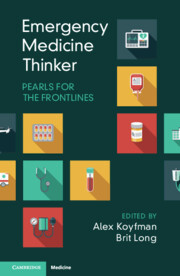Book contents
- Emergency Medicine Thinker
- Emergency Medicine Thinker
- Copyright page
- Contents
- Contributors
- Introduction
- Section 1 Decision-Making
- 1 On Deciding to Not Decide
- 2 What Makes Emergency Medicine Decision-Making Unique and Why?
- 3 Pediatric Emergency Medicine Approach: Be Vigilant but Be Reasonable
- 4 Decision-Making in Emergency Medicine
- 5 Emergency Medicine Medical Decision-Making
- 6 Decisions
- 7 Emergency Thinking and Behavior
- 8 Emergency Medicine Decision-Making
- 9 Emergency Medicine Decision-Making
- 10 Emergency Medicine Thinking and Cognitive Load Considerations
- 11 Decision-Making in Uncertainty
- 12 Unlearning and Thinking Differently
- 13 Decision-Making in Emergency Medicine
- 14 An Object in Motion
- 15 Too Little or Too Much?
- 16 Decision-Making in Emergency Medicine
- 17 Medical Decision-Making in the Emergency Department: Balancing the Patient’s Health with the Clinician’s Perception of Risk
- Section 2 Clinical Pearls
- Index
- References
16 - Decision-Making in Emergency Medicine
from Section 1 - Decision-Making
Published online by Cambridge University Press: 14 March 2025
- Emergency Medicine Thinker
- Emergency Medicine Thinker
- Copyright page
- Contents
- Contributors
- Introduction
- Section 1 Decision-Making
- 1 On Deciding to Not Decide
- 2 What Makes Emergency Medicine Decision-Making Unique and Why?
- 3 Pediatric Emergency Medicine Approach: Be Vigilant but Be Reasonable
- 4 Decision-Making in Emergency Medicine
- 5 Emergency Medicine Medical Decision-Making
- 6 Decisions
- 7 Emergency Thinking and Behavior
- 8 Emergency Medicine Decision-Making
- 9 Emergency Medicine Decision-Making
- 10 Emergency Medicine Thinking and Cognitive Load Considerations
- 11 Decision-Making in Uncertainty
- 12 Unlearning and Thinking Differently
- 13 Decision-Making in Emergency Medicine
- 14 An Object in Motion
- 15 Too Little or Too Much?
- 16 Decision-Making in Emergency Medicine
- 17 Medical Decision-Making in the Emergency Department: Balancing the Patient’s Health with the Clinician’s Perception of Risk
- Section 2 Clinical Pearls
- Index
- References
Summary
Imagine what emergency care was like in 1960. Hospitals around the world had “rooms” where patients with acute emergencies were directed. In academic centers, a receptionist would guess at the type of problem and page a resident of an “appropriate” specialty to see the patient. In community hospitals, to obtain hospital privileges, it was necessary to staff the emergency room on rotation. This meant that the internist could be present to handle a major trauma, or that the ophthalmologist might be faced with diagnosing and treating an acute stroke. The founders of emergency medicine saw what medical institutions and the healthcare systems didn’t want to see – the need for a new group of physicians who would get specialty training to handle emergencies of all types, and as a full-time job, 24/7. These new emergency medicine specialists could see Anyone, Anything, and Anytime!
- Type
- Chapter
- Information
- Emergency Medicine ThinkerPearls for the Frontlines, pp. 118 - 123Publisher: Cambridge University PressPrint publication year: 2025

